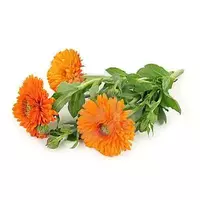Calendula flowers

Calendula belongs to the Complex family. As a rule, calendula flowers differ in yellow or orange color - they can very often be found on garden plots and urban flower beds in the second half of summer. By the way, calendula is a close relative of asters and chrysanthemums, however, it is not so whimsical.
Calendula flowers are not only a joy for the eyes, but also a magnificent seasoning for many dishes. But it should not be forgotten that they taste like several islands, so you need to add them in moderation. Basically, calendula flowers are used in the manufacture of homemade cheeses, all kinds of salads, oil, soups and omelettes. In addition, calendula flowers are a great addition to seafood, rice or spaghetti dishes.
Due to the pigment dye contained in the calendula colors, the addition of some of them will give a characteristic yellow-orange hue to the dough products, as well as many other products. And the fresh petals and buds of the calendula look wonderful as decoration of ready-made dishes.
Calendula types
When compared with other medicinal plants, it is not easy to single out many species of calendula - there are only about twenty of them. But they are cultivated in almost every corner of the globe, with the exception of the permafrost and desert areas. This plant is most widespread in Western Europe, the Mediterranean and Asia.
In Russia, this plant is found everywhere, except for the highlands and remote regions of the Far North. For the most part, it is used as an ornamental plant, but one of the types of calendula, which is called Nogotki medicines, acts as a popular component of various ointments, infusions and other medicines.
Composition of the calendula
The composition of the calendula, in particular in its colors, contains about 3 percent carotenoids, saponins, flavonoids, bitter, resinous, and tannins, essential oil, enzymes, organic acids, alkaloids, vitamin C and other valuable compounds.
The orange color of the petals is due to the considerable content of a special substance that resembles vitamin A in its composition, and explains most of the beneficial properties of calendula. By the way, even the value of raw materials is usually determined by the color of the petals - a cleaner orange color and brighter calendula flowers, the more healing properties this plant has.
The benefits of calendula
The benefits of calendula for human health are contained in the chemical composition of this plant, which is characterized by antiseptic and anti-inflammatory qualities. It was found that the use of calendula colors and drugs based on it has a choleretic effect, contributes to a decrease in blood pressure, and also acts calming on the CNS, improving sleep. In addition, the benefits of calendula are obvious due to the presence of astringent, sweating, disinfecting and blood-cleansing properties in this flower.
calendar colors 15 kCal
Energy value of calendula flowers (Ratio of proteins, fats, carbohydrates - ju):
Proteins: 2.9 g (~ 12 kCal)
Fats: 0 g (~ 0 kCal)
Carbohydrates: 0.2 g (~ 1 kCal)
Energy ratio (bj | y): 77% | 0% | 5%
 Español
Español Français
Français Português
Português Русский
Русский 简体中文
简体中文 繁體中文
繁體中文 日本語
日本語 한국어
한국어 العربية
العربية Türkçe
Türkçe Қазақ
Қазақ Deutsch
Deutsch Italiano
Italiano Українська
Українська
